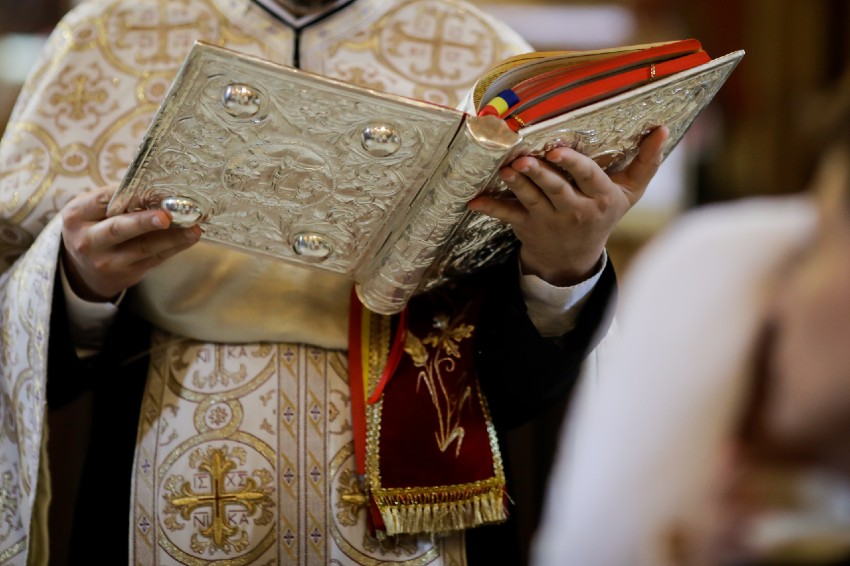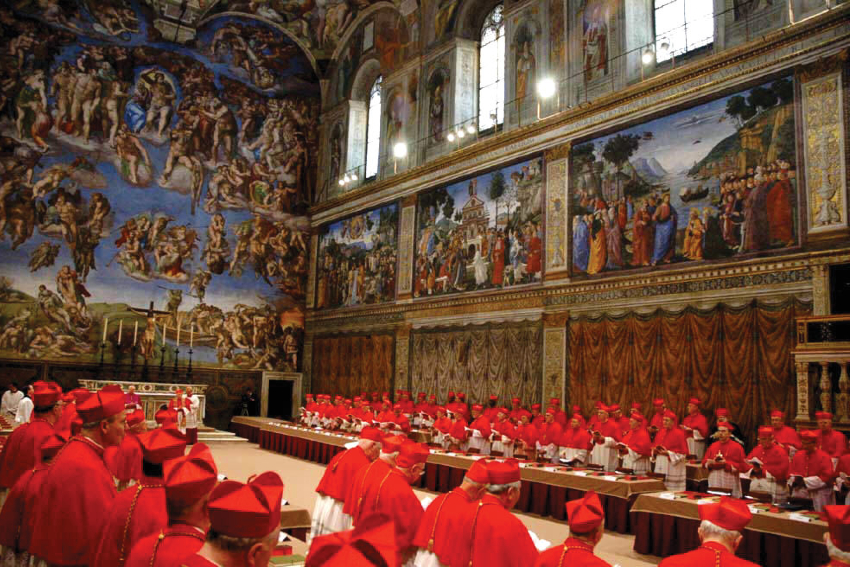A Divorce, and a Memory…
The Vatican archives today presented a facsimile copy of a 500-year-old Appeal of the British Lords to Rome on behalf of Henry VIIIth in his effort to divorce Catherine of Aragorn. And an elderly monsignor remembers Pius XII. Plus, more on the upcoming encyclical…
By Robert Moynihan, reporting from Rome
A cool, sunny day in Rome — and now a cool evening. Hardly like the searing heat of many of the Junes I have known here for the past 25 years…
Centuries ago, history unfolded at a slower pace. Today, news flashes around the world almost instantaneously. But 500 years ago, King Henry VIII took six years from the moment he decided to divorce his wife, Catherine of Aragorn, until the moment he actually divorced her and married the fiery Anne Boleyn — whose execution he ordered a few years later.
This morning, in the Palazzo della Cancelleria, a beautiful palace about a mile from the Vatican which is nevertheless a part of the Vatican’s territory in the heart of Rome, a panel of distinguished scholars presented a facsimile edition of one of the most important documents in the history of Great Britain (photo).
In early 1530, 479 years ago, 83 British nobles (about 70% of the House of Lords of that time), including numerous abbots and bishops who were all Roman Catholics and still, like King Henry himself, fully united with Rome, wrote to Pope Clement VII pleading with him to grant Henry’s request for a marriage annulment. The document was sealed by each man, and sent to Rome (it took three months to arrive).
And when he received the document, Pope Clement was not moved. He refused to grant the annulment.
Unwilling to accept the decision, Henry VIII — who had been a very strong Catholic, writing a theological treatise in defense of the seven Church sacraments against the Lutherans — decided that he would proclaim himself the head of the Christian Church in England, and Anglicanism began.
In a sense, this document is a the precise mid-point of the 6-year process that led to the schism that divided London from Rome, and so changed world history.
Now, 200 copies of this historic letter with all its seals have been reproduced in exquisite detail by the Vatican in a limited facsimile edition.
The cost: 50,000 euros (£43,000) each.
Each facsimile of the Causa Anglica (“The Anglican Case”) as the three-foot-long document is known, took two months to produce. The Vatican hopes that the facsimiles will be bought by museums and national libraries around the world.
The project was timed to coincide with Wednesday’s 500th anniversary of Henry’s coronation in Westminster Abbey in 1509
The copies were produced by Scrinium, a specialist publisher linked to the Holy See but based in Venice. Venetian glass workers were employed to reproduce the wax seals in minute detail.
Mr David Starkey, a leading British historian of the Tudor period, was present and said the document was arguably the most important single document in British history. The turn from Rome set Britain, and then America, on an entirely different historical path. If Henry’s divorce had not occurred, and he had not broken with Rome, and if England had remained Catholic, and Western Europe had remained religiously united, the entire history of the past 500 years would have been different, he said.
This evening, I visited an 89-year-old monsignor inside the Vatican who remembers meeting Pope Pius XII in 1944 — before the end of the Second World War.
Monsignor Giuseppe Simonazzi is 89. He was born in 1920 — the same year as Pope John Paul II — in central Italy. He entered the seminary at age 16, and came to Rome in the 1940s to study for the priesthood.
I am trying to talk with as many old monsignors as I can, to collect their memories of those days, and of Pius XII in particular.
When I called Simonazzi this afternoon, he agreed to see me immediately. He lives in the residence of the canons of St. Peter’s Basilica, which is off to the side of the basilica, near the Campo Teutonico (the German cemetery).
I asked him what he thought of Pius XII, and of the people who criticize his war-time role.
“I knew Pius,” he told me this evening (we spoke in Italian). “I met him personally on several occasions. But one didn’t have to meet him to know what type of man he was. It was enough to look at him and be struck with admiration for the man.
“In those days, it was not hard to see the Pope. It was enough to walk through the Bronze doors and up the Scala Regia, and wait in one of the interior rooms, like the Sala Clementina. And after his morning audiences, the Pope would walk out from his private quarters and greet those of us, perhaps 50 or so, who were waiting to see him.
“It was a very different world, completely different, a world that I recall, but cannot resurrect. Not better, or worse, but different. The technological advances have been astonishing. But is it better? I don’t know. I think we have lost a considerable amount of human feeling. I mean, in our houses in those days, we never locked our doors, never…”
I asked the old priest if he had ever spoken personally with Pius.
“Yes,” he said. “On one occasion. It was February 2, 1944, the Feast of the Presentation of Jesus in the Temple. And we came to bring candles to the Pope. I came with Monsignor Robert Ronca, rector of the major seminary. And after I said to the Pope, ‘Here is my candle,’ the Pope turned to Monsignor Ronca and said: ‘How many are with you in the seminary,’ meaning how many refugees, including Jews, we were housing. And Monsignor Ronca said, ‘402 persons, Holy Father.’ And then Pope Pius said to him, ‘Please, find more spaces.’ And then he held out his hands to take the candles, and I gave him the gift.”
“Were there Jewish refugees staying in the seminary?” I asked.
“Yes, many,” he said. “But we had many right here in the Vatican!” He gestured with his hand.
The old priest had to have supper, and we parted, he to eat, and I to make my way down the elevator, and out along the edge of the basilica, and down into St. Peter’s Square.
The Pope’s new encyclical is only a few days away now. I have been continuing to read the Church’s social teaching from the past century, and the writings of those who have contributed advice to this encyclical. I will be able to write a more complete report soon.
But what is clear is that the encyclical will speak in categories that go beyond the usual economic discussion. The letter will not focus just on earnings and profits and lossses, but on the meaning of work, on the goal of producing goods, on the ends of human life. There will be a discussion of anthropology — what is a man? What is a human person? And how does the nature of man affect our understanding of his economic activity, its justice and injustice, its usefulness and its wastefulness?
One of the key concepts which will be discussed is that the goal of society is to create relationships worthy of human beings, of human persons created in the image of God, and that this includes something more even than the concept of justice. There is more than justice in the concept of the free gift, and yet the free gift, inside a family, or between two friends, or even between strangers, is an economic transaction which transcends the calculation of most economics textbooks.
The idea of the economy for man, and not man for the economy, will be among the ideas in this upcoming encyclical, as will the idea of the gift which creates the common good, which creates a society where people are treated as persons with transcendent dignity, and not as consumers, or clients, to be satiated.
Special note to readers: We would be happy to receive feedback from our readers about these newsflashes. This newsflash is currently being sent to 14,200 people around the world. We hope it meets with your approval, and we will be happy to try to improve it according to your suggestions and needs. —The Editor“Inside the Vatican is a magazine I read cover to cover. I find it balanced and informative. I especially appreciate its coverage of art and architecture. It is not only an important magazine, it is also a beautiful one.” —Prof. Mary Ann Glendon, Harvard University Law School, former United States Ambassador to the Holy SeeThis newsflash is free. However, there are costs associated with producing it. If you would like to support this free newsflash, you may click on the icon above and contribute via credit card. If you would like to make a token gift of $1 per month, or $12 per year, it will help us to expand and improve this service. You may call our toll-free number in the USA, 1-800-789-9494, and ask how you may support our work. —The Editor






Facebook Comments